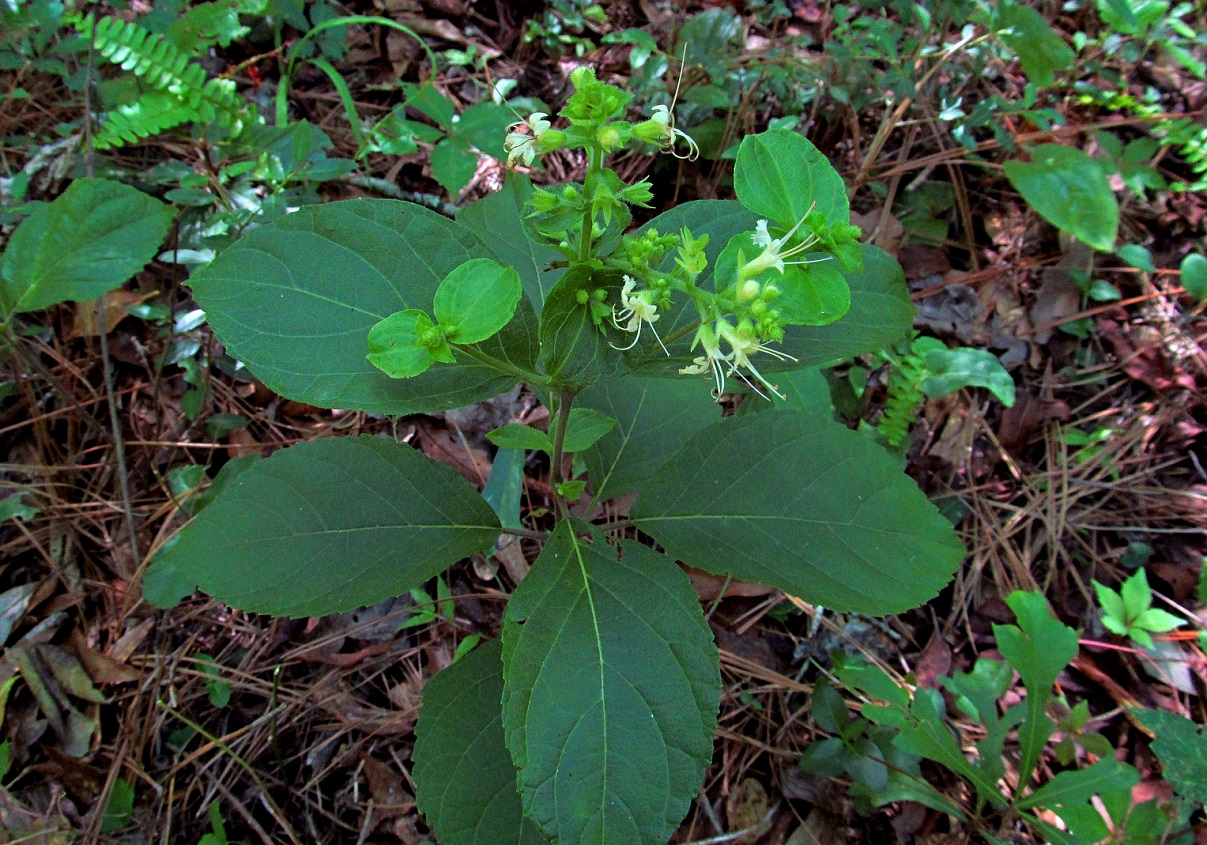Collinsonia anisata
| Collinsonia anisata | |
|---|---|

| |
| Photo by the Altas of Alabama Plants Database | |
| Scientific classification | |
| Kingdom: | Plantae |
| Division: | Magnoliophyta - Flowering plants |
| Class: | Magnoliopsida - Dicots |
| Order: | Lamiales |
| Family: | Lamiaceae |
| Genus: | Collinsonia |
| Species: | C. anista |
| Binomial name | |
| Collinsonia anisata Walter | |

| |
| Natural range of Collinsonia anisata from Weakly [1] | |
Common Names: Southern Horsebalm; Anise Horsebalm[1]
Contents
Taxonomic Notes
Synonyms: Collinsonia serotina Walter; Collinsonia canadensis L. var. punctata (Elliott) A. Gray; Collinsonia punctata Elliott; Micheliella anisata (Sims) Briquet.[2]
The taxanomic identification of this species seems highly debated in the literature, making a specific description that differentiates it from other species difficult. Collinsonia anisata is almost identical to Collinsonia punctata except for having a scent of aniseed and the number of stamen (four).[3] In a 2006 manuscript, C. anisata is suggested to be distinct species of C. serotina by containing 4 stamen, rather than 2.[4] A taxonomic revision of Collinsonia (Lamiaceae) based on phenetic analyses of morphological variation.[5]
Description
A South Carolina specimen from 1806 was described as having erect, lightly hairy stems of 2-3 ft (0.61-0.91 m) high. Leaves are petioled, cordate to ovate, acuminate, crenate-dentate, pale underneath, and covered with pellucid dots. Inflorescence contain compound terminal racemus with simpler axillary ones. Seeds are globular.[6] This species has been observed to have 4 fertile stamens, a strong anise-like aroma, stiffly spreading leaves and branches, and to reach a height of 160 cm tall.[7]
Distribution
This species occurs from central Georgia, southwest to the Florida panhandle, and westward to southern Mississippi.[1][4]
Ecology
Habitat
C. anisata is found in rich forests.[1] It has been observed in a wooded ravine, a bluff along a creek, a wooded patch along a drainage, a shaded mesic woods along river border, an open wooded hillside, and a pine-oak sandhill slope. This species is known to grow on moist loamy sand and sandy loam soils.[7]
Associated species include Pinus palustris, Carya glabra, Quercus falcata, Quercus pumila, Morella cerifera, and Rubus cuneifolius.[7]
Phenology
In the southeastern and mid-Atlantic United States, C. anisata flowers from late July through September and fruits from September through October.[1] It has also been observed to flower in October, and in May in the off-season.[7]
Conservation, cultivation, and restoration
Cultural use
For humans, it medicinally has similar properties to C. canadensis, which has been used for colic, and to treat various symptoms including pains in the bladder, ascites, dropsy of ovaries, and rheumatism. The most successful preparation of the plant is into essential oils, which serves as a tonic for treatment like small grade fevers.[8]
Photo Gallery
References and notes
- ↑ 1.0 1.1 1.2 1.3 1.4 Weakley, Alan S. 2015. Flora of the Southern and Mid-Atlantic States: Working Draft of 21 May 2015. University of North Carolina, Chapel Hill, North Carolina. 1320 pp.
- ↑ Weakley, A.S. 2015. Flora of the southern and mid-atlantic states. Working Draft of 21 May 2015. University of North Carolina at Chapel Hill, Chapel Hill, North Carolina.
- ↑ Ward DB (2014) Thomas Walter typification project, VII: Observations on the genus Collinsonia (Labiatae) and a neotype for C. serotina Walter. Phytoneuron 89:1-5.
- ↑ 4.0 4.1 Peirson JA, Cantino PD, Ballard, Jr. HE (2006).
- ↑ Systematic Botany 31(2):398-409.
- ↑ Sims J (1809) Collinsonia anisata Curtis's Botanical Magazine 30:t.1213.
- ↑ 7.0 7.1 7.2 7.3 Florida State University Robert K. Godfrey Herbarium database. URL: http://herbarium.bio.fsu.edu. Last accessed: March 2019. Collectors: Loran C. Anderson, Bob Farley, Floyd Griffith, Edwin Keppner, and William Platt. States and Counties: Florida: Jackson, Leon, and Washington. Georgia: Thomas.
- ↑ Porcher, F. P. (1869). Resources of the southern fields and forests, medical, economical, and agricultural. Richmond, VA, Order of the Surgeon-General.